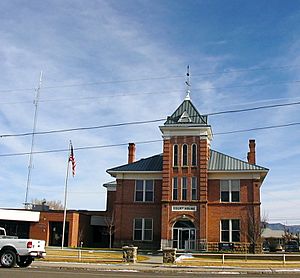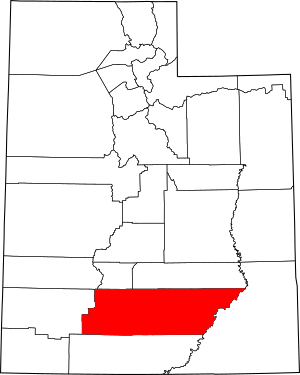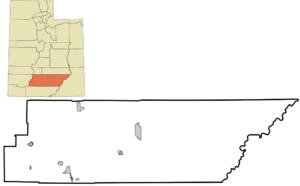Garfield County, Utah facts for kids
Quick facts for kids
Garfield County
|
|
|---|---|

Garfield County Courthouse in Panguitch, December 2006
|
|

Location within the U.S. state of Utah
|
|
 Utah's location within the U.S. |
|
| Country | |
| State | |
| Founded | March 9, 1882 |
| Named for | James A. Garfield |
| Seat | Panguitch |
| Largest city | Panguitch |
| Area | |
| • Total | 5,208 sq mi (13,490 km2) |
| • Land | 5,175 sq mi (13,400 km2) |
| • Water | 33 sq mi (90 km2) 0.6% |
| Population
(2020)
|
|
| • Total | 5,083 |
| • Density | 0.97600/sq mi (0.37684/km2) |
| Time zone | UTC−7 (Mountain) |
| • Summer (DST) | UTC−6 (MDT) |
| Congressional district | 2nd |
Garfield County is a county located in south-central Utah, United States. In 2020, about 5,083 people lived there. This makes it one of the least populated counties in Utah. It also has the fewest people per square mile. The main city and county seat is Panguitch.
Contents
History of Garfield County
The Utah Territory government created Garfield County on March 9, 1882. It was formed from parts of Iron County. The county was named after James A. Garfield. He was the twentieth President of the United States and had passed away just six months before. The county's border with Iron County was slightly changed in 1884. Since then, Garfield County's boundaries have stayed the same.
Geography of Garfield County
Garfield County is known for its amazing natural beauty. The Colorado River flows through a deep gorge, forming the eastern border. The Dirty Devil River also flows south through the eastern part of the county.
The land here is very rugged and has been shaped by erosion. It includes many mountains, plateaus, and canyons. Most of Bryce Canyon National Park is in the southwest part of the county. The northern half of the Grand Staircase–Escalante National Monument is in the middle. A large part of Capitol Reef National Park is in the east-central area. Even a small piece of Canyonlands National Park touches the northeast corner.
The highest point in Garfield County is Mount Ellen. It is located in the Henry Mountains, reaching about 11,522 feet (3,512 meters) above sea level. The county covers a total area of 5,208 square miles (13,489 square kilometers). Most of this is land, with only a small amount of water. Garfield County is the fifth-largest county in Utah. It is about the same size as the state of Connecticut.
Airports in Garfield County
- Bryce Canyon Airport (BCE)
Major Highways in Garfield County
Counties Next to Garfield County
- Wayne County - to the northeast
- San Juan County - to the east
- Kane County - to the south
- Iron County - to the west
- Beaver County - to the northwest
- Piute County - to the north
Protected Natural Areas
Garfield County is home to many protected lands, including:
- Bryce Canyon National Park (part)
- Canyonlands National Park (part)
- Capitol Reef National Park (part)
- Carcass Canyon Wilderness Study Area
- Dixie National Forest (part)
- Escalante Petrified Forest State Park
- Fishlake National Forest (part)
- Glen Canyon National Recreation Area (part)
- Grand Staircase–Escalante National Monument (part)
- Mammoth Cave (US Forest Service)
Lakes in Garfield County
- Lake Powell (part)
- Panguitch Lake
- Wide Hollow Reservoir
Population of Garfield County
| Historical population | |||
|---|---|---|---|
| Census | Pop. | %± | |
| 1890 | 2,457 | — | |
| 1900 | 3,400 | 38.4% | |
| 1910 | 3,660 | 7.6% | |
| 1920 | 4,768 | 30.3% | |
| 1930 | 4,642 | −2.6% | |
| 1940 | 5,253 | 13.2% | |
| 1950 | 4,151 | −21.0% | |
| 1960 | 3,577 | −13.8% | |
| 1970 | 3,157 | −11.7% | |
| 1980 | 3,673 | 16.3% | |
| 1990 | 3,980 | 8.4% | |
| 2000 | 4,735 | 19.0% | |
| 2010 | 5,172 | 9.2% | |
| 2020 | 5,083 | −1.7% | |
| US Decennial Census 1790–1960 1900–1990 1990–2000 2010 2020 |
|||
In 2000, there were 4,735 people living in Garfield County. The population density was less than one person per square mile. Most people in the county were White (about 95%). About 3% of the population was Hispanic or Latino.
There were 1,576 households in the county. About 38% of these households had children under 18 living with them. The average household had about 2.9 people. The average family had about 3.4 people.
The median age in the county was 34 years old. This means half the people were younger than 34, and half were older. About 32% of the population was under 18 years old.
Communities in Garfield County
Cities
Towns
Unincorporated Communities
See also
 In Spanish: Condado de Garfield (Utah) para niños
In Spanish: Condado de Garfield (Utah) para niños


